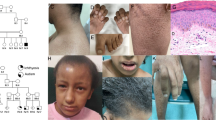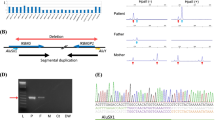Abstract
Striated (Str) and bare patches (Bpa) are X-irradiation-induced, X-linked dominant mouse mutations that are lethal prenatally in hemizygous males. To map the Str mutation, we generated a backcross involving Mus castaneus. Pedigree analysis of 193 affected female and normal male progeny from the cross places Str extremely close to DXMIT1 and favors a gene order of (Cf-9)-Ids-Gabra3-DXS1104h-(Str, DXMIT1)-F8a-DXPas8-DXBay6-DXMIT6 for the loci studied. This region of the mouse X Chromosome (Chr) is syntenic with proximal human Xq28. Based on the mode of inheritance and clinical phenotype, Str may be a homolog of human familial incontinentia pigmenti (IP2). Further refinement of our genetic mapping of bare patches positions that locus between DXS1104h and DXPas8 in the same region as Str, raising the possibility that Bpa and Str may be allelic or are due to mutations in overlapping contiguous genes.
Similar content being viewed by others
References
Ballabio, A. and Andria, G. (1992). Deletions and translocations involving the distal short arm of the human X chromosome: review and hypotheses. Hum Mol Genet 4, 221–227.
Bardoni, B., Guioli, S., Raimondi, E., Heilig, R., Mandel, J.-L., Ottolenghi, S., and Camerino, G. (1988). Isolation and characterization of a family of sequences dispersed on the human X chromosome. Genomics 3, 32–38.
Brown, S.D.M., Avner, P., Herman, G.E. (1992). Mouse X Chromosome. Mammalian Genome 3 (Suppl), S274-S288.
Buckle, V.J., Fujita, N., Ryder-Cook, A.S., Derry, J.M.J., Barnard, P.J., Lebo, R.V., Schofield, P.R., Seeburg, P.H., Bateson, A.N., Darlison, M.G., and Barnard, E.A. (1989). Chromosomal localization of GABA, receptor subunit genes: relationship to human genetic disease. Neuron 3, 647–654.
Connor, J.M., Gatherer, D., Gray, F.C., Pirrit, L.A., and Affara, N.A. (1986). Assignment of the gene for dyskeratosis congenita to Xq28. Hum Genet 72, 348–351.
Davisson, M.T. (1987). X-linked genetic homologies between mouse and man. Genomics 1, 213–227.
Dietrich, A., Korn, B., and Poustka, A. (1992a). Completion of the physical map of Xq28: the location of the gene for L1CAM on the human X Chromosome. Mammalian Genome 3, 168–172.
Dietrich, W., Katz, H., Lincoln, S.E., Shin, H.-S., Friedman, J., Dracopoli, N., and Lander, E.S. (1992b). A genetic map of the mouse suitable for typing intraspecific crosses. Genetics 131, 421–445.
Faust, C.J. and Herman, G.E. (1991). Physical mapping of the loci Gabra3, DXPas8, CamL1, and Rsvp in a region of the mouse X chromosome homologous to human Xq28. Genomics 11, 154–164.
Faust, C.J., Levinson, B., Gitschier, J., and Herman, G.E. (1992a). Extension of the physical map in the region of the mouse X chromosome homologous to human Xq28 and identification of an exception to conserved linkage. Genomics 13, 1289–1295.
Faust, C.J., Verkerk, A.J.M.H., Wilson, P.J., Morris, C.P., Hopwood, J.J., Oostra, B.A., and Herman, G.E. (1992b). Genetic mapping on the mouse X chromosome of human cDNA clones for the Fragile X and Hunter syndromes. Genomics 12, 814–817.
Freije, D. and Schlessinger, D. (1992). A 1.6-Mb contig of yeast artificial chromosomes around the human factor VIII gene reveals three regions homologous to probes for the DXS115 locus and two for the DXYS64 locus. Am J Hum Genet 51, 66–80.
Happle, R., Phillips, R.J.S., Roessner, A., and Jünemann, G. (1983). Homologous genes for X-linked chondrodysplasia punctata in man and mouse. Hum Genet 63, 24–27.
Hearne, C.M., McAleer, M.A., Love, J.M., Aitman, T.J., Cornall, R.J., Ghosh, S., Knight, A.M., Prins, J.-B., and Todd, J.A. (1991). Additional microsatellite markers for mouse genome mapping. Mammalian Genome 1, 273–282.
Herman, G.E. and Walton, S.J. (1990). Close linkage of the murine locus bare patches to the X-linked visual pigment gene: implications for mapping human X-linked dominant chondrodysplasia punctata. Genomics 7, 307–312.
Herman, G.E., Faust, C.J., Darlison, M.G., and Barnard, E.A. (1991a). Genetic mapping of the mouse X chromosome in the region homologous to human Xq27-Xq28. Genomics 9, 670–677.
Herman, G.E., Berry, M., Munro, E., Craig, I.W., and Levy, E.R. (1991b). The construction of human somatic cell hybrids containing portions of the mouse X chromosome and their use to generate DNA probes via interspersed repetitive sequence polymerase chain reaction. Genomics 10, 961–970.
Korn, B., Sedlacek, Z., Manca, A., Kioschis, P., Konecki, D., Lehrach, H., and Poustka, A. (1992). A strategy for the selection of transcribed sequences in the Xq28 region. Hum Mol Genet 1, 235–242.
Levinson, B., Bermingham, Jr. J.R., Metzenberg, A., Kenwrick, S., Chapman, V., and Gitschier, J. (1992). Sequence of the human factor VIII-associated gene is conserved in mouse. Genomics 13, 862–865.
Lyon, M.F. Order of loci on the X-chromosome of the mouse. (1966). Genet Res 7, 130–133.
Lyon, M.F. and Searle, A.G. (1989). Genetic variants and strains of the laboratory mouse. (Oxford: Oxford University Press).
Naritomi, K., Izumikawa, Y., Nagataki, S., Fukushima, Y., Wakui, K., Niikawa, N., and Hirayama, K. (1992). Combined Goltz and Aicardi syndromes in a terminal Xp deletion: are they a contiguous gene syndrome? Am J Med Genet 43, 839–843.
Phillips, R.J.S. (1963). Striated, a new sex-linked gene in the house mouse. Genet Res 4, 151–153.
Phillips, R.J.S., Hawker, S.G., and Moseley, H.J. (1973). Barepatches, a new sex-linked gene in the mouse, associated with a high production of XO females. Genet Res 22, 91–99.
Poustka, A., Dietrich, A., Langenstein, G., Toniolo, D., Warren, S.T., and Lehrach, H. (1991). Physical map of human Xq27-qter: localizing the region of the fragile X mutation. Proc Natl Acad Sci USA 88, 8302–8306.
Rinchik, E. (1991). Chemical mutagenesis and fine-structure functional analysis of the mouse genome. Trends Genet 7, 15–21.
Schlessinger, D., Little, R.D., Freije, D., Abidi, F., Zucchi, I., Porta, G., Pilia, G., Nagaraja, R., Johnson, S.K., Yoon, J.-Y., Srivastava, A., Kere, J., Palmieri, G., Ciccodicola, A., Montanaro, V., Romano, G., Casamassimi, A., and D'Urso, M. (1991). Yeast artificial chromosome-based genome mapping: some lessons from Xq24-q28. Genomics 11, 783–793.
Sefiani, A., Abel, L., Heuertz, S., Sinnett, D., Lavergne, L., Labuda, D., and Hors-Cayla, M.C. (1989). The gene for incontinentia pigmenti is assigned to Xq28. Genomics 4, 427–429.
Sefiani, A., M'rad, R., Simard, L., Vincent, A., Julier, C., Holvoet-Vermaut, L., Heuertz, S., Dahl, N., Stalder, J.F., Peter, M.O., Moraine, C., Maleville, J., Boyer, J., Oberlé, I., Labuda, D., and Hors-Cayla, M.C. (1991). Linkage relationship between incontinentia pigmenti (IP2) and nine terminal X long arm markers. Hum Genet 86, 297–299.
Traupe, H., Müller, D., Atherton, D., Kalter, D.C., Cremers, F.P.M., van Oost, B.A., and Ropers, H.-H. (1992). Exclusion mapping of the X-linked dominant chondrodysplasia punctata/ichthyosis/cataract/short stature (Happle) syndrome: possible involvement of an unstable pre-mutation. Hum Genet 89, 659–665.
Wettke-Schäfer, R. and Kantner, G. (1983). X-linked dominant inherited diseases with lethality in hemizygous males. Hum Genet 64, 1–23.
Author information
Authors and Affiliations
Rights and permissions
About this article
Cite this article
Angel, T.A., Faust, C.J., Gonzales, J.C. et al. Genetic mapping of the X-linked dominant mutations striated (Str) and bare patches (Bpa) to a 600-kb region of the mouse X Chromosome: implications for mapping human disorders in Xq28. Mammalian Genome 4, 171–176 (1993). https://doi.org/10.1007/BF00352233
Received:
Accepted:
Issue Date:
DOI: https://doi.org/10.1007/BF00352233




